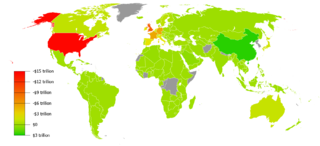
Following their defeat in World War I, the Central Powers agreed to pay war reparations to the Allied Powers. Each defeated power was required to make payments in either cash or kind. Because of the financial situation in Austria, Hungary, and Turkey after the war, few to no reparations were paid and the requirements for reparations were cancelled. Bulgaria, having paid only a fraction of what was required, saw its reparation figure reduced and then cancelled. Historians have recognized the German requirement to pay reparations as the "chief battleground of the post-war era" and "the focus of the power struggle between France and Germany over whether the Versailles Treaty was to be enforced or revised."

Debt is an obligation that requires one party, the debtor, to pay money borrowed or otherwise withheld from another party, the creditor. Debt may be owed by sovereign state or country, local government, company, or an individual. Commercial debt is generally subject to contractual terms regarding the amount and timing of repayments of principal and interest. Loans, bonds, notes, and mortgages are all types of debt. In financial accounting, debt is a type of financial transaction, as distinct from equity.

In international economics, the balance of payments of a country is the difference between all money flowing into the country in a particular period of time and the outflow of money to the rest of the world. In other words, it is economic transactions between countries during a period of time. These financial transactions are made by individuals, firms and government bodies to compare receipts and payments arising out of trade of goods and services.

The Bretton Woods system of monetary management established the rules for commercial relations among the United States, Canada, Western European countries, and Australia as well as 44 other countries after the 1944 Bretton Woods Agreement. The Bretton Woods system was the first example of a fully negotiated monetary order intended to govern monetary relations among independent states. The Bretton Woods system required countries to guarantee convertibility of their currencies into U.S. dollars to within 1% of fixed parity rates, with the dollar convertible to gold bullion for foreign governments and central banks at US$35 per troy ounce of fine gold. It also envisioned greater cooperation among countries in order to prevent future competitive devaluations, and thus established the International Monetary Fund (IMF) to monitor exchange rates and lend reserve currencies to nations with balance of payments deficits.

Financial services are economic services tied to finance provided by financial institutions. Financial services encompass a broad range of service sector activities, especially as concerns financial management and consumer finance.

The Dawes Plan temporarily resolved the issue of the reparations that Germany owed to the Allies of World War I. Enacted in 1924, it ended the crisis in European diplomacy that occurred after French and Belgian troops occupied the Ruhr in response to Germany's failure to meet its reparations obligations.

The Young Plan was a 1929 attempt to settle issues surrounding the World War I reparations obligations that Germany owed under the terms of Treaty of Versailles. Developed to replace the 1924 Dawes Plan, the Young Plan was negotiated in Paris from February to June 1929 by a committee of international financial experts under the leadership of American businessman and economist Owen D. Young. Representatives of the affected governments then finalised and approved the plan at The Hague conference of 1929/30. Reparations were set at 36 billion Reichsmarks payable through 1988. Including interest, the total came to 112 billion Reichsmarks. The average annual payment was approximately two billion Reichsmarks. The plan came into effect on 17 May 1930, retroactive to 1 September 1929.

Robert Spear Hudson, 1st Viscount Hudson, was a British Conservative Party politician who held a number of ministerial posts during World War II.
The Anglo-Irish Trade War was a retaliatory trade war between the Irish Free State and the United Kingdom from 1932 to 1938. The Irish government refused to continue reimbursing Britain with land annuities from financial loans granted to Irish tenant farmers to enable them to purchase lands under the Irish Land Acts in the late nineteenth century, a provision which had been part of the 1921 Anglo-Irish Treaty. This resulted in the imposition of unilateral trade restrictions by both countries, causing severe damage to the Irish economy.

Sir Otto Ernst Niemeyer was a British banker and civil servant. He served as a director of the Bank of England from 1938 to 1952 and a director of the Bank for International Settlements from 1931 to 1965.

The Lausanne Conference of 1932, held from 16 June to 9 July 1932 in Lausanne, Switzerland, was a meeting of representatives from the United Kingdom, France, Italy, Belgium, Japan and Germany that resulted in an agreement to lower Germany's World War I reparations obligations as imposed by the Treaty of Versailles and the 1929 Young Plan. The reduction of approximately 90 per cent was made as a result of the difficult economic circumstances during the Great Depression. The Lausanne Treaty never came into effect because it was dependent on an agreement with the United States on the repayment of the loans it had made to the Allied powers during World War I, and that agreement was never reached. The Lausanne Conference marked the de facto end of Germany's reparations payments until after World War II.

The Anglo-American Loan Agreement was a loan made to the United Kingdom by the United States on 15 July 1946, enabling its economy after the Second World War to keep afloat. The loan was negotiated by British economist John Maynard Keynes and American diplomat William L. Clayton. Problems arose on the American side, with many in Congress reluctant, and with sharp differences between the treasury and state departments. The loan was for US$3.75 billion at a low 2% interest rate; Canada loaned an additional US$1.9 billion. The British economy in 1947 was hurt by a provision that called for convertibility into dollars of the wartime sterling balances the British had borrowed from India and others, but by 1948, the Marshall Plan included financial support that was not expected to be repaid. The entire loan was paid off in 2006, after it was extended six years.
The Hungarian Interwar Economy was the economy of Hungary in the period between the end of the First World War and the start of the Second World War. It was dominated by the effects of the Treaty of Trianon and the Great Depression. The economy suffered from inflation and reperation payments stipulated by the Treaty of Trianon. The economy of Hungary began to recover after a trade agreement with Germany, which influenced Hungary's joining of the Axis.

The London Agreement on German External Debts, also known as the London Debt Agreement, was a debt relief treaty between the Federal Republic of Germany and creditor nations. The Agreement was signed in London on 27 February 1953, and came into force on 16 September 1953.
A sovereign default is the failure or refusal of the government of a sovereign state to pay back its debt in full when due. Cessation of due payments may either be accompanied by that government's formal declaration that it will not pay its debts (repudiation), or it may be unannounced. A credit rating agency will take into account in its gradings capital, interest, extraneous and procedural defaults, and failures to abide by the terms of bonds or other debt instruments.

Foreign trade of the United States comprises the international imports and exports of the United States. The country is among the top three global importers and exporters.

The British credit crisis of 1772–1773, also known as the crisis of 1772, or the panic of 1772, was a peacetime financial crisis which originated in London and then spread to Scotland and the Dutch Republic. It has been described as the first modern banking crisis faced by the Bank of England. New colonies, as Adam Smith observed, had an insatiable demand for capital. Accompanying the more tangible evidence of wealth creation was a rapid expansion of credit and banking, leading to a rash of speculation and dubious financial innovation. In today's language, they bought shares on margin.
The Second Economic Adjustment Programme for Greece, usually referred to as the second bailout package or the second memorandum, is a memorandum of understanding on financial assistance to the Hellenic Republic in order to cope with the Greek government-debt crisis.
International relations (1919–1939) covers the main interactions shaping world history in this era, known as the interwar period, with emphasis on diplomacy and economic relations. The coverage here follows the diplomatic history of World War I and precedes the diplomatic history of World War II. The important stages of interwar diplomacy and international relations included resolutions of wartime issues, such as reparations owed by Germany and boundaries; American involvement in European finances and disarmament projects; the expectations and failures of the League of Nations; the relationships of the new countries to the old; the distrustful relations between the Soviet Union and the capitalist world; peace and disarmament efforts; responses to the Great Depression starting in 1929; the collapse of world trade; the collapse of democratic regimes one by one; the growth of economic autarky; Japanese aggressiveness toward China; fascist diplomacy, including the aggressive moves by Fascist Italy and Nazi Germany; the Spanish Civil War; the appeasement of Germany's expansionist moves toward the Rhineland, Austria, and Czechoslovakia, and the last, desperate stages of rearmament as another world war increasingly loomed.

The Hague conference on reparations of 1929-30 was an international conference on World War I reparations that reviewed and adopted the Young Plan, the final attempt during the Weimar Republic to settle the reparations issue. The conference was held in The Hague, Netherlands in two parts, from 6 to 31 August 1929 and from 3 to 31 January 1930.













